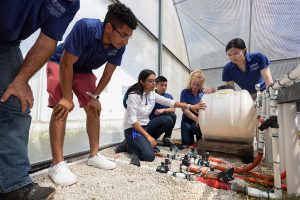FORT PIERCE, Fla.—In this national Smart Irrigation month, we honor graduate student Eduart Murcia for his work in bringing the next generation of advanced irrigation technology to Florida food producers.

Murcia is a current Ph.D. student at the University of Florida’s Indian River Research and Education Center (IRREC) in Fort Pierce, Florida. The center is part of UF’s Institute Food and Agricultural Sciences (UF/IFAS) statewide service to growers and water managers.
Smart Irrigation
Smart irrigation employs weather and sensor data to provide rapid solutions for irrigation management and sustainable food production.
“Eduart Murcia’s innovational findings as a master’s student in Dr. Sandra Guzmán’s Smart Irrigation and Hydrology lab will contribute to provide an easy-to-use tool for Florida to deliver only the precise amount of water crops need,” said IRREC Director Mark Kistler.
Dr. Sandra Guzmán
Kistler said Guzmán’s team employs artificial intelligence in its irrigation technology applications, or apps, and simulations. Guzmán developed, IrrigMonitor “a centralized software platform that provides real-time insights into soil moisture and future irrigation needs.” The centralized data visualization tool is a tool for growers to monitor and manage their crops more efficiently.

IrrigMonitor
IrrigMonitor is a tool that involves “the Internet of Things,” in irrigation.
Under Guzmán’s leadership, she guides Murcia as he takes irrigation and hydrology science one step further—to artificial intelligence (AI), which Murcia calls machine learning. Although AI sweeps the globe and impacts many technology disciplines, Guzmán and Murcia understand that AI must begin with human minds’ capabilities.
Publication
Murcia’s former master’s research targeted complex data collected from soil moisture sensors in agricultural research production lands. For more information about Murcia’s research, visit the publication, “Using Singular Spectrum Analysis and Empirical Mode Decomposition to Enhance the Accuracy of a Machine Learning-Based Soil Moisture Forecasting Algorithm,” authored by Murcia and Guzmán, published by Science Direct.
From the data sets, Murcia extracts the most useful information, trains an AI-based algorithm to learn the dynamics of the water moving through the soil, and couples it with software that will automate smart irrigation. Murcia’s research centers on machine learning algorithms and ways to make them more efficient. He aims to sustain both crops and valuable water with minimal waste.
“The sensors measure soil moisture in each crop field,” Murcia said. “I used multiple processing algorithms to assess and maintain the quality of this sensor data. This is important as AI relies on data not only from these sensors, but also from weather conditions and crop management practices. High-quality data will provide the most reliable findings for IrrigMonitor users”
IrrigMonitor shows the real-time amount of water available for plants to uptake. Guzmán and Murcia are seeking the best data set combinations derived from a group of sensors installed at commercial crop fields to make a centralized recommendation system, describing it as “one stop for all.”
A platform that has learned what a crop needs on a given day and hour will activate in-field devices, which have learned from data refined by scientists, to irrigate crops according to their specific needs. The platform will incorporate weather conditions, soil moisture, water volume in root zones, the volume of water per each tree space, the actual water required for each tree, the number of trees per acre, and the volume of water per acre.
“From my master’s research, we observed results that could lead to significant water savings of up to more than 1 million gallons of water within the context of large commercial operations,” Murcia said. “It’s the kind of outcome we expect and hope to achieve for our growers.”
 9
9
